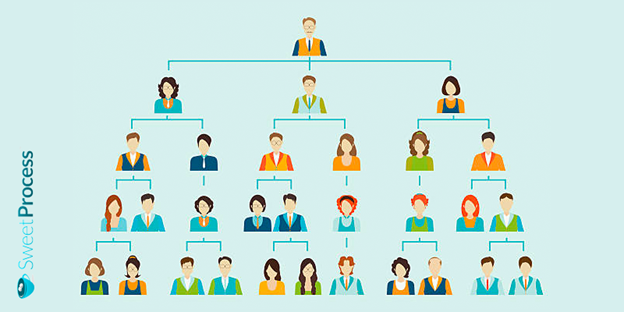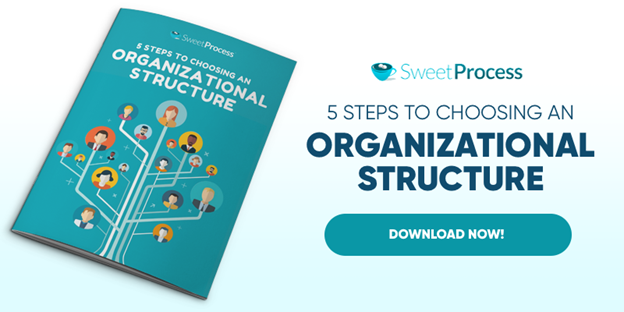Last Updated on March 4, 2025 by Owen McGab Enaohwo
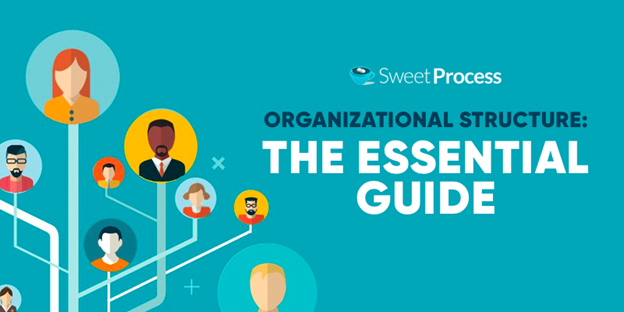
As a business owner, it might seem trivial to create a work structure at the development stage of your business. But as you grow and expand, it will become impossible to fill all the roles in your growing organization yourself.
See it this way: You can’t build the perfect house without outside help.
The significance of erecting an organizational structure is that it creates a flow for all business activities and defines the hierarchical layout within the business. You will have multiple employees working under you who know who they answer to and their roles in achieving goals and objectives.
While all that sounds interesting, building an organizational structure is challenging. Since there is no one-size-fits-all model for every business, it’s up to you to determine what kind of structure works for your business. Choosing the wrong one could stifle the creativity of your employees or, ironically, obstruct rather than streamline workflow.
To help you avoid these issues, we devised an extensive guide to help you better understand organizational structures and how they work. You will also learn how to choose a system that suits your business model.
Organizational Structure Guide – Chapter Index
Chapter 1: What is an Organizational Structure?
Chapter 2: What Are the Key Elements of an Organizational Structure?
Chapter 3: Types of Organizational Structures
Chapter 4: Examples of Organization Structure Usage
Chapter 5: Why is an Organizational Structure Important for Businesses?
Chapter 6: Using SweetProcess to Map Your Organizational Structure
Chapter 1: What is an Organizational Structure?

An organizational structure is the pattern of operations that defines how employees communicate and conduct activities within an organization. This pattern of operations is what helps the employees achieve goals and objectives unique to the organization.
The organizational structure also provides a visual framework of the hierarchy within the organization, which is usually achieved with the help of organizational charts.
For example, most large-scale organizations have a chief executive officer (CEO), vice presidents (VPs), managers, and employees. The employees answer to the managers, who in turn receive instructions from their superiors, the VPs. The VPs then answer directly to the CEO.
Because of this structure, there is an orderly flow of communication within the chain of command.
Chapter 2: What Are the Key Elements of an Organizational Structure?
Check out this slideshow to learn more (view all slides)
Five core elements define the success of an organizational structure.
Those elements include:
Span of Control
In an organizational structure with a hierarchical nature, the employees directly report to the managers, not the VPs or the CEOs, regardless of the number of employees at each level. So if there are ten employees assigned to one manager in your organization, the span of control of that manager is 10. Likewise, if there are four employees under the manager, then their span of control is four.
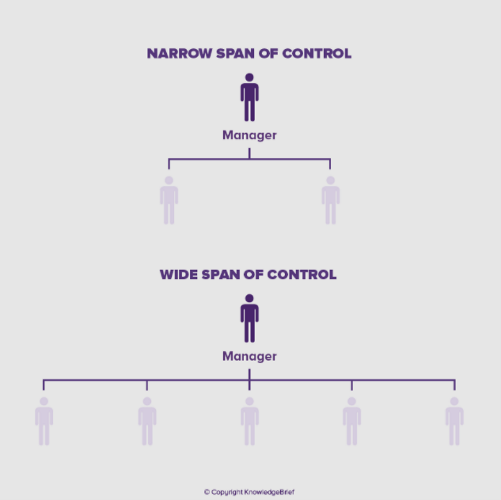
Source: kbmanage.com
The span of control simply refers to the number of employees or workers under one manager. Managers with a narrow span of control have the luxury of supervising their staff more closely. That means employees can communicate with them one-on-one more frequently. But the downside of this is that managers can become too involved in the activities of their staff, which can hinder their creativity.
The opposite is the case for managers with a wider span of control. The staff here are more independent, possibly because they are highly skilled, experienced, and need less supervision by their managers. However, managers are faced with a higher workload.
The span of control can be influenced by several factors, such as:
- The size and nature of the organization: Large organizations require more hands on deck. Typically, the more employees there are to manage, the higher the span of control.
- The nature of the job or employee routines: Complex employee roles require more supervision. In an organization with more complex roles than menial ones, there is a reduction in the span of control. This is so that the managers can closely supervise their employees to improve the quality of the employees output.
- The skill level of the manager and employee: Managers with higher levels of expertise and experience in communicating with and directing employees are in better positions to handle more numbers of employees. So the higher the manager’s skill, the wider the manager’s span of control. Also, if the employees have a low level of experience, they will require more supervision. The span of control here will be narrow so that managers can focus closely on each employee.
Examples of such low-level employees are interns and employees who’ve just transferred to a new department. In a hypothetical situation where there are 1,000 low-level or newly recruited employees, there would be 200 managers. The average span of control for each manager would be five employees.
Departmentalization
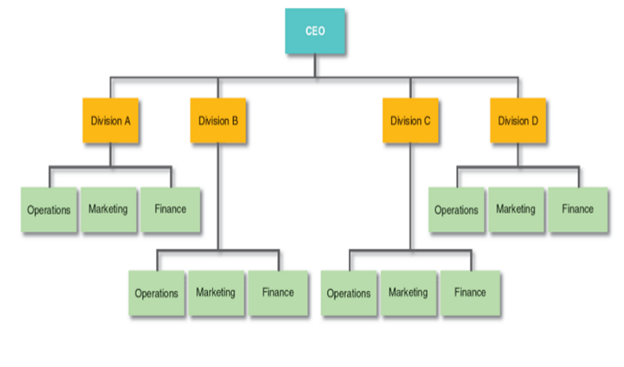
This process involves division of labor. It refers to when the organization divides its employees and activities into departments to meet its needs and solve problems. Each department specializes in different functions.
For example, in a law firm there is a marketing department. The marketing department is in charge of devising strategies to draw in more clients. Then there is the IT team, which handles the firm’s technological needs.
As a new business owner, the best way to create departments within your structure is to evaluate your resources and needs.
This includes considering what systems the departments will need to function properly. It helps if you design a process map or cheat sheet for each department. These maps should contain information about what you want the department to do for you. Is it to handle financial reports? Will it handle marketing or product manufacturing? Once you’ve answered these questions, write down job positions needed in the department and procedures that will go on under it. Is the department going to need automation? What kind of technology will they need to work and communicate efficiently?
Once you have answered these questions you can decide how best to structure your departments. Some organizations choose function. Others choose to organize by product, location, process, or even customer type.
Chain of Command
The chain of command in an organizational structure refers to the hierarchical arrangement. Superiors like the CEO and his or her board of directors sit at the top of the chain. Managers and supervisors are in the middle. At the same time, the low-level management personnel are placed at the bottom of the pyramid.
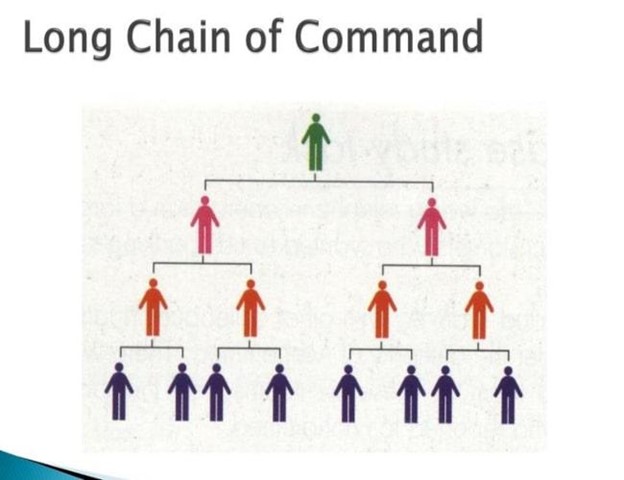
The CEOs are responsible for the overall performance and decision-making process of the organization. Upper-level management develops goals and objectives that support the company’s mission. The managers execute those goals and objectives by mapping and structuring them into more discrete activities for the employees.
Supervisors are at the bottom of the management pyramid. Their job is to coordinate and monitor employees daily as they strive toward achieving the organization’s goals and objectives and to ensure they are performing well.
Work Specialization
This refers to the degree to which organizations divide employees into different departments. The more you break down tasks in your organization, the smaller they become, and it becomes easier for employees to complete them faster. For example, the marketing department wants to create a successful campaign. Lucy is in charge of determining the budget, while Tom does the market research. Another employee, Anna, handles the SEO aspect of the campaign. When all of them are through with their tasks, they hand everything over to Bob. Bob is the guy who makes sure nothing’s missing before the campaign goes public. This is how the marketing team eventually creates a successful campaign.
The major advantage of work specialization is that it helps employees master a particular skill for increased productivity. If Anna from our example continues to apply her SEO skills in creating marketing campaigns, she becomes better at her job. In the long run, she becomes a professional and is able to perform her role faster and with precision. With a higher skill level and experience, she is at less risk of being replaced than an intern who’s just learning the ropes of SEO.
The downside is that Anna becomes a master of that one skill. When your employees are restricted to just one role in the organization, it puts them at risk of becoming obsolete. For example, with automation revolutionizing the business world, there are now more tools and software than we can count on for completing tasks faster. As your business adapts to these technological changes, employees like Anna can easily be replaced since she’s unable to adapt her skills to the new environment.
Centralization and Decentralization
Centralized organizational structures like the hierarchical structure concentrate authority in one figurehead—the CEO. The CEO makes the most important decisions concerning the organization, so there is little autonomy. In these hierarchical structures, lower-level employees can’t vote against company policies or be involved in the decision-making process.
On the other hand, decentralized structures, like the flat organizational structure, emphasize team operations. There is freedom for employees to make suggestions and voice concerns about essential matters in the organization.
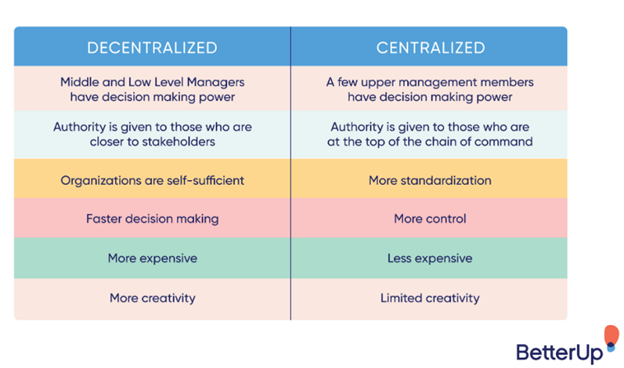
Chapter 3: Types of Organizational Structures
Hierarchical Structure
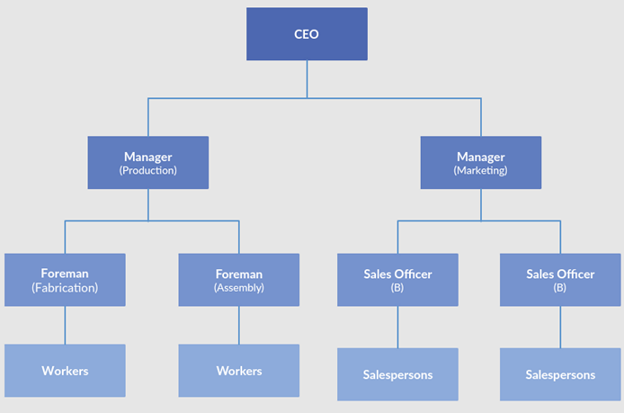
In a hierarchical organizational structure, a chain of command flows from the top to the bottom. For example, communication of authority passes from the CEO down to employees. So even though the CEO is the boss and calls the shots, they don’t just walk up to the employees to give them orders and regulate their activities. Instead, some managers and supervisors act as messengers in passing on that information.
The hierarchical structure of your organization can be either tall and narrow or wide. As the organization grows, the structure becomes taller. The need for more managers and employees increases. This is because the theme of this structure is centralization. The head of the organization holds the most power. So even while other levels of the organization are expanding, the CEO remains the same.
At the startup phase of your organization, characterized by little to no hierarchy levels, the chain of command becomes wide. Since the span of control under such an organization is wide, there will be less need to micromanage or supervise the activities and performances of employees. In addition, the organization grows when your employees become more experienced, and there is still room for more hands on deck. Old employees transition to new and higher positions to create space for new recruits. When the organization has grown to a stable level characterized by a sufficient number of employees and defined roles, the process of transitioning to new roles stops.
Pros of a hierarchical structure
- Organization leaders can define levels of authority and responsibility under the structure.
- It helps employees narrow their focuses on objectives to achieve them faster.
- There is room for employees to elevate to higher levels on the hierarchy ladder. This motivates them to perform better.
Cons of a hierarchical structure
- The communication system is slow in tall hierarchical structures because of the many levels of management a message must pass through to get from the CEO to the workers.
- Lack of collaboration as lower-level employees are stuck in their assigned departments where there’s no room to think outside the box—or department.
Functional Organizational Structure
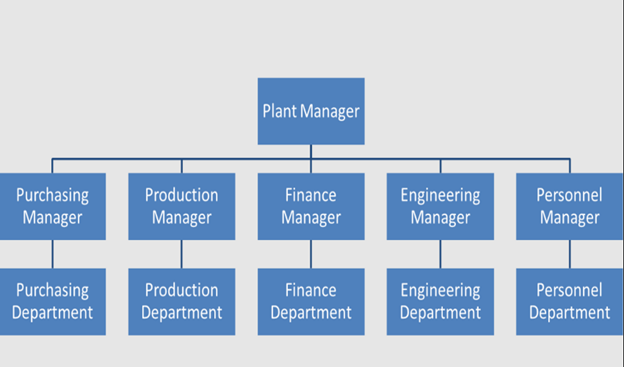
This structure is often used by small to medium organizations and is based on the hierarchical structure. Under it, employees are grouped into departments that suit their specialties such as sales departments, marketing departments, IT departments, etc. After their segregation, a manager or supervisor is placed as the department head.
The purpose of the structure is to ensure there’s uniformity within the organization. When employees with similar skills are grouped under one department, it creates a repetitive environment. This means the employees continually handle tasks that require a particular skill.
For example, the accounting department is in charge of handling your organization’s general ledger and preparing financial statements. The more employees under this division continue to harness their accounting skills, the more experienced they become. As a result, there are fewer occurrences of human error in financial statements and higher output quality over time.
Pros of a functional organizational structure
- Objectives are accomplished faster. Big tasks are broken down and assigned to different employees with the experience and skillset to handle them.
- It eliminates duplication of task results and reduces business costs as each team of employees is different and can’t produce the same results.
- It reduces the workload of employees.
Cons of a functional organizational structure
- Collaboration is low as employees are confined within their departments.
- Competition and conflicts can ensue among departments as in and out groups are formed.
Divisional Structure
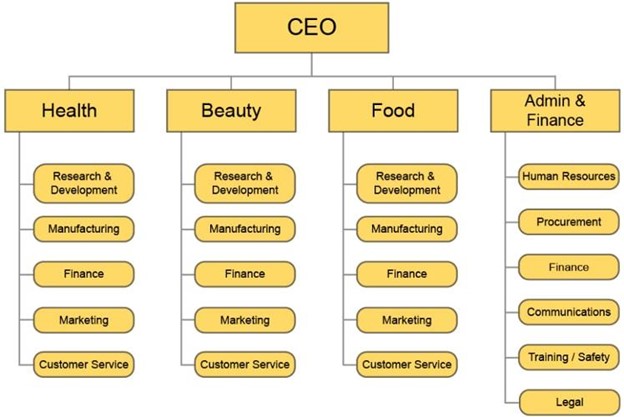
Divisional structures work similarly to the functional structure. Both involve splitting employees into separate units where they can focus on achieving organizational goals. But there is a significant difference. Divisional organization structures work best in multi-brand companies. That is a company that sells multiple product lines.
Take, for example, Unilever. Unilever produces all Dove, Lipton, and Breyers products. To ensure efficiency and faster production, employees are separated into different divisions. One division will handle the production and packaging of Lipton refreshments, another division will oversee the production of Breyer ice creams, and another unit will handle Dove beauty products. This type of divisional structure is known as the product-based divisional structure.
Under each division are departments. These departments include the production, marketing, sales, human resources, and finance departments. All these departments can exist under Dove, Lipton, and Breyer divisions.
Pros of divisional structures
- It creates room for accountability since employees are separated to handle the production of specific products or services. If there are inconsistencies in the processes, it’s easier to trace who is responsible.
- It gives organizations a competitive advantage, especially for geographic divisions. For example, Starbucks has divisions across the global market that allows it to sell coffee at an international scale.
- It encourages teamwork as employees within a division can interact and communicate freely to achieve their goals and objectives.
Cons of divisional structures
- It may stir competition between divisions. Divisions may see each other as rivals, which will cause them to have independent goals to strive to be better than the other. While this can encourage productivity, it could also leave gaps between divisions. For example, some organizations might reward their higher performing divisions with a bigger budget.
- It’s not suitable for small organizations, even though they may produce varieties of goods and services. This is because the structure is resource-intensive and costly.
Matrix Structure
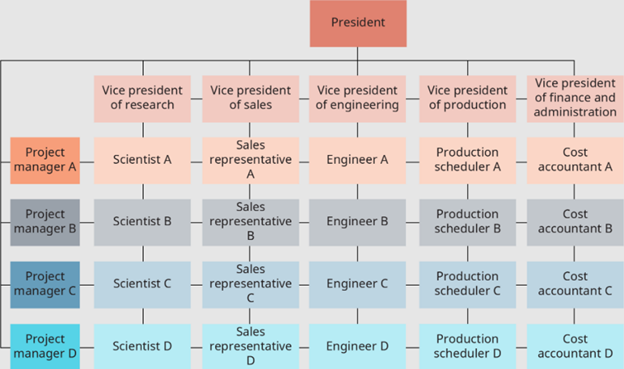
If your organization chooses to run the matrix structure, it means you will have a hybrid structure that combines the features of a functional structure and the benefits of product departmentalization.
For example, employees will be divided into departments. Each employee is assigned to a department and then pulled out of the department to work on a specific project. This employee reports to two managers: one manager will act as a departmental head while the other acts as a project leader. The project leaders bring people together from many departments to work on a short-term project or product.
This structure is usually temporary and is ideal for situations where employees may need to work on projects outside their department. You may wonder why they would need to leave their departments when the sole aim of departmentalization is to divide and conquer objectives. But one challenge of departmentalization is that employees are forced to focus solely on the departments they are assigned to. There would be no inter-departmental collaboration to handle tasks.
In such scenarios, the matrix structure comes in handy when employee skills need to be shared across departments. This allows them to complete tasks faster.
Types of Matrix Structures
Your organization’s matrix structure can either be weak, balanced, or strong.
Weak matrix structure
Under a weak matrix structure, the project manager has little authority. Their roles are similar to that of a coordinator. Meanwhile, the primary manager is the head of the department where the employees were originally assigned. The project manager is in charge of a project existing outside that department. In a weak matrix structure, departmental projects take priority over others.
So if the primary manager feels the departmental projects need more attention, he may decide to keep employees working on those projects instead of independent projects outside his department. He also gets a say in how the budget is allocated to projects.
Balanced matrix structure
In balanced matrix structures, there is equality between the project and department managers. This means team members can report to both sides about project-related information and no project takes priority over the other. Resources are also equally distributed to both projects.
Strong matrix structure
For strong matrix structures, the project manager is the one with the most authority. The departmental manager acts as a coordinator by offering her support and expertise to the project where needed. This is the ideal form of matrix structure because the whole purpose of the structure is to work on a particular project outside the conventional departments.
Large organizations such as Starbucks often use it. At Starbucks, employees report to a human resource manager and a divisional manager. This cross-collaborative arrangement gives Starbucks flexibility to adjust to different market conditions.
Pros of matrix structures
- Matrix structures are more flexible than the hierarchical model. This allows employees to communicate faster.
- It encourages the “outsider’s perspective” approach to problem solving. As a result, organizations will uncover hidden pain points faster.
- It also encourages cross-interaction between employees and reduces rivalry. With teamwork as the focus, productivity levels will increase.
- It enhances resource gathering as employees and equipment needed for projects are pulled from the various departments.
Cons of matrix structures
- It may cause conflict between managers. For example, the confusion of which master to serve may arise from inconsistent instructions from both managers.
- It may cause employee burnout as employees can be assigned multiple tasks across different projects.
Flat Structure
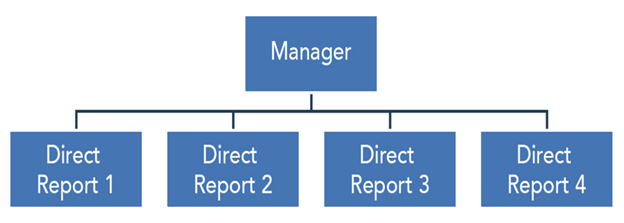
In a flat organizational structure, there are little to no levels of management between the CEO and the lowest level of employees. This structure creates room for an autonomous environment where employees are deeply invested in decision-making processes within the organization.
This structure is characterized by shorter or no levels of management. Because of this, they do not need a hierarchical structure. However, the chain of command here is wider. That means under one manager there can be 10 or more employees because the number of managers is limited.
Most small or startup businesses use this structure, although large organizations also use it because of their dynamic market. The dynamic market is one that continues to change at a rapid speed; for example, Samsung and Facebook.
The benefit of using this structure is that it is decentralized. Power and authority don’t reside with the CEO or major stakeholders as employees are also involved in the decision-making process. This helps with employee retention. When employee feedback and opinions are considered, they are more likely to stay at the company longer.
But the risk of using this structure is that it could limit productivity. Managers under this structure are not closely involved in employee activities because their span of control is wide. So if there are inconsistencies in an employee’s work, it can slow down progress toward completing goals and objectives.
Pros of a flat structure
- There is limited bureaucracy. Employees have the freedom to contribute their inputs in decision-making processes.
- Communication is informal and flows in all directions as there are few or no middle authority figures to report to.
- It costs the organization less to maintain as the chain of command is leaner.
Cons of a flat structure
- Employee workloads are increased as there’s no departmentalization or segregation into smaller teams.
- It causes a lack of direction among employees as there’s no manager or supervisor to direct their focus.
Chapter 4: Examples of Organization Structure Usage

Many large organizations use organizational structures to organize their workflow behind the scenes. This is how they can deliver products or services that satisfy their customers.
Here are three examples of prominent organizations and their organizational structures:
GitLab
GitLab is a popular company that provides free, open-source software for managing business team projects. This software runs on a development and operations (DevOps) platform that allows teams to unify, track, and automate changes to their projects.
GitLab uses a functional organizational structure. Within this structure, there are seven levels of authority:
- The CEO
- Executives: The chief people officer and the chief technology officer
- Senior leader
- Director
- Senior manager
- manager
- Individual contributor (IC)
Directors or VPs lead each department in GitHub’s functional structure. The departments are further divided into various teams.
The ICs are managers of one. This means they are free to create objectives and goals for employees to follow. Basically, they have almost the same level of authority as managers do. They can operate unsupervised by the manager, although they still have to report to the manager about team progress.
Meanwhile, the senior managers and managers are in charge of communicating roles and objectives to the lower levels of authority and monitoring their performances. The difference between both is that the manager has a span of control ranging from four to 10. This pattern of authority continues up to the CEO, who spearheads the overall operations of the organization.
Starbucks
Starbucks Corps. is the largest chain of coffeehouses worldwide. The organizational structure within Starbucks uses the matrix model.
Within this model, there is a functional system of hierarchy where employees are divided into departments. A human resource manager leads each department, and authority is centralized. That means the CEO is the ultimate decision-maker within the corporation.
Starbucks also has geographic company divisions across America, Asia, and Africa. Each division has a senior executive in charge. So in a division where there are both department heads and senior executives present, employees report to both heads to address the geographic divisional needs.
There is also a product-based division where employees are divided into groups that focus on creating specific products. For example, Starbucks offers not just coffee to customers but also baked goods and customized mugs for coffee.
To address these product lines, employees branch out into separate groups to handle their production. There will exist coffee-making divisions, baked-goods divisions, and custom mug–making divisions outside the regular departments.
Furthermore, employees are broken into teams to deliver these services at the coffeehouses. These include the baristas, store managers, and shift supervisors.
Valve
Valve is a video game company that produces popular single-player games like Dota and Counter-Strike.
The company has an entirely flat organizational structure:
Although there is a co-founder, owner, and CEO (Gabe Newell), there is no other level of authority. This means no managers, and the organization runs with a decentralized authority and flexibility in employee operations.
Employees can decide which projects to prioritize over others. They can also decide when to form and dissolve groups concerning projects.
For example, one employee may decide to create a new game. That employee is solely in charge of putting together a team for the game production, known as a “cabal.” The team leader is also in charge of gathering the resources needed to make the game a success.
Other Types of Organizational Structures
The Bureaucratic Structure
Pre-bureaucratic structures
In pre-bureaucratic structures, there is centralization of authority. The CEO or owner of the business is the sole decision-maker, with a few employees working under them. Beyond that, there is no ladder of authority. Instead, employees speak directly to the CEO about day-to-day activities. The pre-bureaucratic structure model best suits new and small companies.
Bureaucratic structures
Your organization can adopt the bureaucratic model when it has grown and has a tall chain of command. Authority is still centralized here, but the significant difference is that now there are more levels in the chain of command. For example, you act as the CEO at the top, and you can have senior executives and managers below you. Information passes from the top down to the bottom of the organization where the lowest-level employees reside.
Post-bureaucratic structures
Hierarchy and centralized control still dominate the post-bureaucratic organizational structure. However, there are more board members at the top of the chain of command, so the strings of control are slightly loosened. The CEO does not make decisions without consulting board members first, and a “majority carries the vote” system is set in place. Though lower-level employees don’t partake in major decision-making processes, the work environment is an open one. What this means is that employees are not always hired full-time. They can be part-time workers or temporarily hired staff. So unlike full-time employees, they are free from the constraints of the typical bureaucratic structure. For example, they often don’t have fixed work hours.
Circular structures
The circular structure is much like the hierarchical structure. However, if you were to draw it on your org chart, it would look like this: The chain of command does not flow in an up-to-down movement from the CEO to the lowest employee. Rather, it is structured to be round. The CEO or head of the organization sits at the center. Besides the center, there is an outer ring of authority where other major stakeholders reside such as vice presidents and managers. The last ring surrounding the organization is occupied by the regular employees.
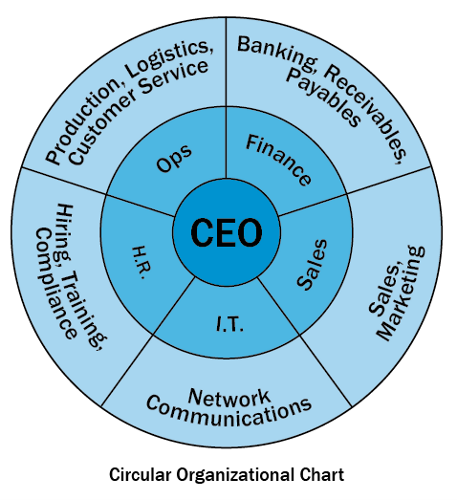
Virtual Structure
This organizational structure comprises virtual teams of employees working together temporarily and remotely to work on projects. The team communicates via emails, phone calls, and on video conference platforms like Zoom.
After the completion of the project, this virtual team dissolves. Most startup businesses without a physical base of operations use this structure.
Network Structure
Like the flat organizational structure, the network structure is decentralized and less hierarchical. One other unique feature of the structure is social networking. This structure works best for companies that want to outsource major business processes to other companies in similar lines of work with theirs.
For example, Nike is one of the largest sportswear companies in America. To cut production costs, the company designs all its footwear, and then outsources the production of its shoes to manufacturing plants in Asia, including countries like China, India, Vietnam, and Malaysia. This establishes an external relationship between Nike and the Chinese manufacturers. Since the relationship is an external one, the typical levels of management in most mechanistic structures are eliminated.
The benefit of this structure, besides cost reduction, is that organizations can properly focus on their core or primary processes. This is because the other company in the network bears the responsibility of the other processes.
Open-Value Network Structure
These types of structures are highly decentralized. For example, Bitcoin, Ethereum, and most other cryptocurrency networks use this type of structure. There is no physical structure or chain of command through which processes flow. So individuals under this structure complete projects and share information with each other through a technology-based platform without a middle man to supervise the interaction.
What is the Best Organizational Structure?

Now that you know all about the various organizational structures, it’s time to choose which one suits your company best.
Small or startup businesses should use a flat organizational structure. This is because there is little need for hierarchy at the initial stage of your business operations, especially when you have less than a handful of employees at your service.
So even though the functional structure may bring orderliness to your business, it can also overwhelm your employees and slow down communication.
More importantly, the flat structure will give you, the business owner, more time to get acquainted with your business and learn about the other types of structures. This way, you will know when it’s time to switch to a different organizational structure.
You can transition into the functional or matrix model when your business has grown into a sizable multi-brand company. These models will help employees, especially new ones, to know who their superiors are after the onboarding process. It also gives them a clear idea of their roles as one person in charge of their department guides, instructs, and supervises their activities.
In other words, the different stages of business growth can influence what structure you adopt in streamlining the backend activities of your organization over time or as the business expands.
How Growth Stages of a Business Can Affect Organizational Structure
The life cycle of every business revolves around five stages. These stages span from the business’s launch to the final stage, the maturity stage. Each stage is characterized by different challenges that threaten the efficiency of employees. Businesses can easily predict these challenges and adjust their structures to overcome them by adopting the proper organizational structure.
Launch and Development Stage
At the development stage of your business, there is no physical office or structure. There are only ideas. This is the point where you scrap ideas off your list until you settle on “the one.”
It’s easy to buckle under the pressure of starting a business, especially without funding or research. This is why a good business plan is necessary.
A good business plan gives you a realistic view of your business ideas. You will be able to sketch your ideas on paper and assess their strengths and weaknesses. This will help you determine if the business is viable or not.
After choosing the best business idea, your business plan creates room for a fail-safe plan. This is your go-to alternative when the origin plan fails. In essence, a business plan will sustain your business long enough to secure funds for its growth.
Startup Stage
This is the stage when you have successfully established your business. The significant problems you might face include:
- Sourcing funds or investors for your business.
- Establishing your market presence.
- Onboarding employees.
You will need to convince people to invest in your business and research ways to attract customers who don’t know your brand. You will also need to hire employees, but not so many to warrant a hierarchical structure.
On that note, AVC blogger Fred Wilson says, “The number of people you have in your company at any time is a vital part of getting the company building process right. Too many, and you will slow things down, burn through too much cash, and increase management overhead for no real benefit.”
Since your employees are few, the ideal structure at this stage of your business is the flat organization structure.
Growth, Maturity and Expansion Stages
These stages of your business are characterized by a consistent flow of cash and a growing customer base. Now that the business is increasing in size, it will be challenging to keep track of the frenzy of activities and customer data rushing it. As a result, your business will need a more formal and rigid structure to help employees know their place and be accountable for their roles. For this to happen, a functional structure is necessary.
The more your business grows, the taller the chain of command gets. But, unfortunately, this also means that your structure will become mechanistic. For some companies, this rigid structure works well while for others, it can become an impediment in the long run.
For example, video game companies typically have decentralized or flat structures because of the kind of market they deal with. The gaming industry is ever changing and highly competitive. So there’s a need for creativity and innovation. The same can be said for Facebook, now known as Meta. It would be quite the irony if the social media company were to restrict socializing at the backend.
Chapter 5: Why is an Organizational Structure Important for Businesses?

An organizational structure is essential for numerous reasons. For one, it gives business owners a visual breakdown of what the chain of command looks like. This is possible through the use of an organizational chart. An organizational chart is a diagram that illustrates an organizational structure and the interrelationships of personnel within an organization.
This can serve as a guide to hiring future employees and managing existing ones. When your employees have a clear idea of their roles and the roles above theirs, they can manage their expectations. The anticipation of a promotion to a better position will motivate them to perform better.
Organizational structures also help to improve the decision-making process. For example, in functional structures, employees are divided into departments where each department is placed in charge of tasks and essential aspects of the organization. This segregation method allows for faster data collection concerning each unit, all of which are reported up to the managers, CEO, and board of directors. By working together and sharing input, they can decide what’s best for the organization.
How Do You Measure Organizational Structure Effectiveness?
Streamlining the backend processes of your organization doesn’t just stop at choosing a structure. You also have to monitor your system to see if it’s producing positive results. This will help you determine whether to keep the existing structure or transition to a better one.
Some metrics you can use to measure the success of your organizational structure include:
- Organization performance: One of the signs that your organizational structure is effective is its ability to achieve objectives. You can tell by comparing and contrasting your profits and achievements with the current structure, and your organization’s projected profits and objectives. If there is a massive gap between the timeline you have specified for achieving those objectives, then your structure may not be the ideal one for you.
- Nature of management and accountability: Creating a sound management system is one of the main reasons organizations adopt organizational structures. The structures promote order and fluid communication within the organization. If you have a poor structure within your organization, the synchronization between your employees and the authority heads of their departments or divisions is cut off. As a result, you are more likely to witness employee conflicts, low productivity, high levels of offboarding, and slow progress in achieving objectives.
- Clarity in organizational goals and objectives: An excellent organizational structure creates a vivid mental picture of the main goals and objectives, allowing employees to quickly tell which projects take priority over others and allocate resources accordingly. A well-defined structure also ensures that onboarding and offboarding processes are smooth, minimizing disruptions when employees transition in or out of the organization.
Chapter 6: Using SweetProcess to Map Your Organizational Structure
The challenges that come with running a business never end. Eventually, at the growth stage of your organization, you’ll come to learn that running a successful business goes beyond the intention of satisfying customers.
Now you have to worry about meeting regulatory standards, maintaining consistency in your services and products, and ensuring uniformity in how personnel operate within the organization. Balancing all that is tough, especially when you don’t have an automated system in place.
Founder and managing lawyer at Resolute Legal, David Brannen was a victim of these business pressures. That is until he tried SweetProcess.
David’s biggest challenge was mono-tasking. He was doing everything all by himself with no assistant lawyers to help him spread out his processes. Using SweetProcess, David was able to streamline workflow processes by sharing his workload. He was able to create a searchable repository where every process needed to onboard and train his new team existed. It also helped to keep them focused as “they don’t need to see things that don’t apply to them.” They just need to view the projects assigned to them.
When you don’t have a good organizational structure in place, it’s easy for your employees to drown in the frenzy of activities that happen behind the scenes of the company. Your workflow is bound to be disorganized and employees become distracted.
SweetProcess helps them retain their focus by acting as a digital organizational structure. It enables you to create procedures, processes, or special tasks for various departments or divisions. These procedures contain steps that employees need to follow to complete tasks, such as how to make an espresso at Starbucks. Once you’ve created those procedures, you can assign teams to them.
If all that sounds interesting, there’s more. SweetProcess offers a 14-day free trial to the all-inclusive and web-based software. Sign up now to try all its features without using your credit card details, and then subscribe for a plan later. You have the option to cancel at any time, and there’s a 30-day money-back guarantee.
How Two Businesses Streamlined Their Backend Procedures
Using SweetProcess gave Thomas Parker, quality assurance and sensory contributor, at Stone & Wood and Austin Maxwell, general manager, at Maxwell Counters provisions for enriching text instructions with videos. They were able to add visual illustrations to business process documents, making it easier for old and onboarding staff to visualize, understand and implement those instructions.
From then on, they were both able to create a central knowledge on the SweetProcess software where every employee could sign in and access specific resources quickly.
Both companies were also able to assign tasks in real-time to employees. “We can see that they’ve signed it off. Previously, there wasn’t any sort of tracking as to whether someone had investigated a procedure. That really made the difference,” says Thomas Parker.
Like Thomas and Austin, you can make a difference in your organization with SweetProcess. Imagine one central platform where every piece of information you need to onboard and enlighten employees about work processes, no matter what department they work in, is accessible in just a few clicks.
Organization Chart Types
Similar to the types of organizational structures, there are four major types of organizational charts we’ll be discussing in this section: hierarchical, functional, matrix, and flat charts.
Hierarchical charts
In organizational charts, the authority axis moved from the highest level of authority to the lowest. In other words, there is a top-to-bottom communication of information that forms a pyramid-like structure.
Functional charts
On functional organizational structure charts, the hierarchy structure is depicted such that the CEO is visible as the strongest link. Lines are drawn from the CEO to various department heads leading teams of employees specializing in particular fields such as IT managers, marketing managers, sales managers, etc.
Under these managers are lower-level employees that make up the department.
Matrix charts
The matrix chart depicts employees from various departments reporting to their functional or department heads, just like in the functional chart. However, the difference is that the employees also report to a project manager who leads select employees from these departments on special projects such as the creation of a new product line.
Flat charts
The flat chart has the most straightforward design. There is only one manager or CEO, which all other persons within the organization answer to. There is a straight line linking all those employees to the manager. Utilizing an organizational chart template can be highly beneficial in implementing these structures effectively. These templates provide a clear framework for designing your company’s hierarchy, ensuring that roles and reporting lines are clearly defined.
Conclusion
Building an organizational structure is a fluid process once you understand your business. Understanding your business is key to choosing a structure that allows for better communication, transparency, and accountability, as well as fast-tracking your project management processes.
Consider your business size and resources and ensure that both you and your employees know the organization’s goals and their parts to play in reaching them.
A weak or incompatible organizational structure can stifle the work process behind the scenes which will, in time, affect your service delivery. It’s also overwhelming when you don’t have an integrated data system such as SweetProcess where every resource needed to keep everyone onboard the organization is up-to-date on events or work processes.
To help you plan your organizational structure, we’ve tailored the ultimate guide to help you assess your organization and choose the perfect structure for it. Download our “5 Steps to Choosing an Organizational Structure” below to get started.
